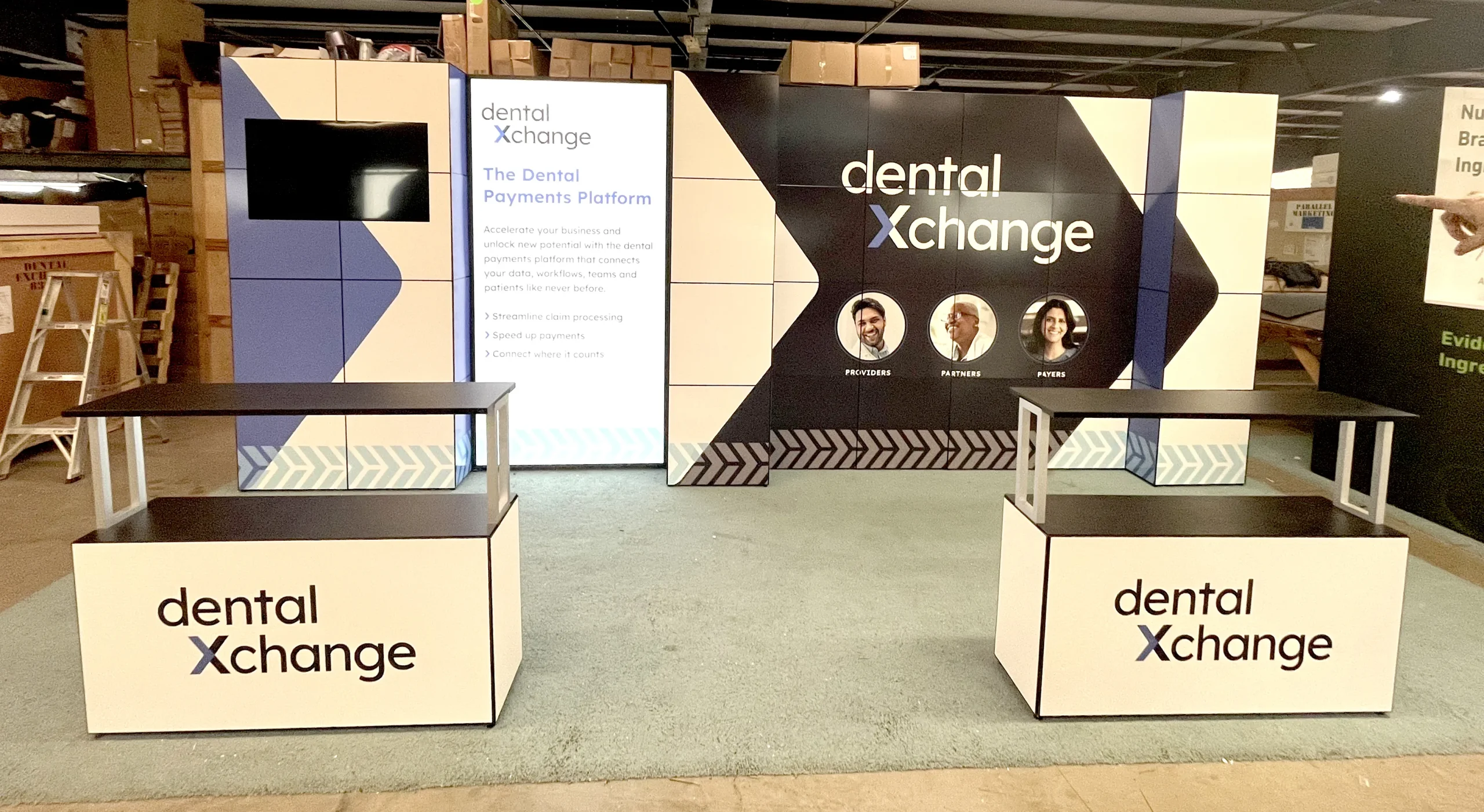Tips For Getting The Best Value From Your Trade Show Exhibit and Exhibiting Experience
Participating in trade shows is a necessary evil for many companies. Each trade show exhibitor has different reasons for making the investment in the raw booth space, the trade show exhibit to fill that raw space, and all the travel expenses to be there. The cost can be a burden to the largest of companies let a lone the individual small business exhibitor trying to get the same value on a smaller scale.
When I work with clients, I also see when companies try to limit a project with too many cost savings which causes them to end up spending more in the end because cheaper isn’t always better.
Rather than looking at your costs in a line-by-line item, look at the big picture. The following are ways you can get more value from your trade show experience, ease the stress of the trade show and minimize the burden it can put on your staff.
Start preparing for your trade show far in advance:
• One area I see trade show exhibitors drop the ball is their preshow marketing. There is a lot of competition to get attendees attention at a trade show, especially in a standard size trade show exhibit space. It’s a good idea to set up appointments before the show. Make sure the people you are meeting with know exactly where you are in the venue, and it helps to put an image of your trade show exhibit on the invite so they know what to look for. The trade show should be able to provide the trade show exhibitor with an attendee list to directly market to them.
• Figure out what your goals are before the trade show. If you have a 10x10 trade show booth at a big show like CES where 150k people attend, you are not going to talk to thousands of people. If you want to get an idea of the amount of potential leads, think about it like this… If the trade show is 3 days long and lasts for 6 hours a day and there are 2 of you in the booth, and each of you talk to 10 people per hour, you’re looking at 360 potential leads that you’ve scanned and talked too.
• They say in business the 3 most important things are location, location, location. That holds true for trade shows, especially when you have a small trade show exhibit space. Try to get a corner spot that’s off a main isle if you can. That offers a better line of site and better traffic opportunities. Being that those are limited, the next best thing is to find the largest booths and be as close to them as you can. The reason is, you get to benefit off of their marketing dollar. Attendees will always go to the biggest players there and you can catch their overflow. Being in areas near the bathroom, escalator or food area is great, but people have a mission when going to these places and are less likely to stop and talk.
Budgeting
• Companies that exhibit need to properly represent themselves. A trade show exhibitor believes their product or service has great value to anyone who would use it. But when an attendee walks up to their booth and the company has a cheap wrinkled banner hanging off the S hooks of the pipe and drape, it’s hard to convince someone you can do something great for them.
• It’s the companies that act like they have value that get the better opportunities.
• There are great products on the market now that are cost effective solutions that look great. On average, keep your absolute minimum budget in the $50-75 sq ft range. That will cover your booth and show fees for the most part.
• Make a proper budget and learn the show manual. Not understanding the show manual will cost you money and the General Contractor who put out the manual won’t care if you didn’t know something that was clearly in the manual.
• If you don’t already own your trade show exhibit, get bids from a few companies and make sure you have a strong understanding of what they are giving you for that price. Get it signed and make sure you go over anything they could potentially charge you for. If you plan to do multiple trade shows you can get a better deal from using the same company. It also helps to build a relationship with your trade show exhibit vendor. Everyone says they’ll walk on water for you but stay with the ones that prove it, again cheaper isn’t always better.
Give-away Items
• Offer a give away item for the end of the trade show. People love the opportunity to win something in trade for a few minutes of their time. A $500 Ipad or similar is cheaper than most other forms of advertising and you get the satisfaction of seeing how excited they are to receive it.
• There are a few ways to offer big-ticket giveaways like a trip, car, motorcycle, etc. You can collect business cards and pick from a jar for the lower priced items or there are marketing insurance companies that offer cost effective big-ticket giveaways for not a lot of money. They offer interactive games or something simple where they can punch a 5-6-digit code in a clear box that has the give away item in it ie keys, tickets, etc. The pricing varies on the giveaway item and the game you want to play.
• If you plan to just hand out items, I recommend getting a couple of different kinds of giveaways. Get something low cost for the mass of people walking by but then get a smaller amount of higher priced items to give to your current or future clients. Whatever you give out, make sure it’s something easy they can bring back. Things like coffee cups are great but rarely will someone take it back with them. There have been studies done that show the most used items after a show and reusable bags were at the top of the list. People will use them on average for 9 months after a show. Get your message to the masses with a simple giveaway.
Lighting
• I’m not a fan of arm lights. I think they are messy, have a limited throw (light spread), different light temperatures can make graphics look bad and you need to have an electrician to install them and take them down. They also usually charge that rate in OT too. Most of the time they never even do the work because exhibitors are taking the booth down quickly and won’t wait for them.
• For trade show booths that are 400 sq. ft. or larger instead of using arm lights attached to your walls, I recommend using ceiling lights. On the electrical order form the show offers a light that has a few names: Par Can, Spot Light, Quartz light, etc. These lights are charged at a flat rate and what is great about them is that they light up your booth instead of just adding lights to graphics. The spread covers about a 10x10 area so you’d need a couple.
• Use them to highlight a product, shine it on a logo, and shine it onto the floor to light up the trade show booth space. I’ve found booths that use them look brighter and more noticeable than their surrounding neighbors.
• These lights are not necessarily cheaper than using the arm lights but once you factor in an electrician laying cable under your carpet, purchasing electric power, having the electrician come back to hook up the lights, then take them down at the end of the show, you will find the cost difference to be minimal if any. It also has a cleaner look without having wires and strip plugs taped to walls or on top.
Outside vendors
• Exhibitors are required to use the General Contactor for certain things at a trade show. Those charges are for things like material handling/drayage, electric, electric labor and hanging sign rigging/assembly, forklift use.
• A trade show exhibitor is also able to bring in outside vendors for labor (even in a union hall), trade show exhibit, carpet, furniture, A/V and trucking to name a few.
• Labor- There are many outside union/non-union labor groups you can use rather than order labor from the show. There is usually a 4-hour minimum for outside groups where using show labor is only an hour minimum. The problem with show labor is you do not know if the person you are getting is any good or not. Just because they are in a “union” doesn’t mean they know how to build a trade show booth or work with the type of booth you have. In using an outside labor company they will have only qualified people that will show up with the proper tools, skills and equipment because they will have an opportunity to look at the renderings and set ups of the booth prior to even showing up. You are also able to hire a company like this to travel with your booth.
o Wouldn’t it be great to show up with your trade show exhibit ready to go and leave when the show ends? How much would that be worth?
o You and your staff can stay a shorter time so less hotels and food costs. That would help to offset the extra labor cost as a much less stress to you and your crew.
o Even though their hourly rate is higher than show rates in most cases they should be able to get the job done in a more reasonable timeframe so that should off-set the higher hourly rate.
o Furniture- is a major cost for a show. In most cases it’s cheaper to buy the furniture and throw it away after. The benefit of using an outside furniture rental company you can in most cases get a better price for the furniture however there are charges for deliver/removal and the material handling fees. When you compare the prices to the show furniture you’ll find that the cost might not be that much different. The prices to bring in the furniture might be a bit more but you will get much better quality furniture for what you would pay for basic furniture from the show. It’s all about being different at the show and unique furniture can be eye catching to attendees
Trucking
• Trucking companies use different classification codes when pricing a shipment. It will depend if the materials are raw, finished, etc. Trade shows also have a classification number. Shipping to a trade show will always be more expensive than shipping warehouse to warehouse. That reason is the wait time. When a truck shows up to drop off you’re your goods they have to wait then wait some more and wait even longer. A driver can have to wait overnight to drop off a load. There are 2 kinds of trucking companies you can use to ship into a trade show. A private carrier and LTL (Less than Truckload freight.)
o LTL are companies like UPS Freight and Yellow/Roadway. Private carriers will either take your freight by itself or mix it with other customers that will go to the same show.
o Pros of using an LTL- it’s cheaper, their trucks usually don’t wait as long as private so there are rarely extra wait charges, less shipping time.
o Pros of using a private carrier- They take better care of your freight, you have a rep that will oversee your freight and you have someone to call if there is an issue, more options for shipping because they can consider many different carriers.
o Cons of using LTL- they don’t take as much personal care with your freight and there is a higher chance of freight getting damaged, less control of your freight, don’t have 1 person to call if there is an issue.
o Cons of using Private- More expensive than LTL, the company can outsource your freight to an unqualified driver without your knowledge, unknown charges for wait time.
o Make sure you also consolidate your freight as much as possible and put it on a skid so a forklift can move it easily. The general contractor will charge extra or “special handling fees” if you freight can’t be lifted with a forklift. They also have minimum material handling charges so if your freight isn’t consolidated they will charge you more for your delivery
Carpet
• The show will rent you carpet with install but the prices are usually pretty high. There are vendors that offer carpet rentals for better pricing than the show, even with the material handling and shipping. At many shows they will do the installation too.
If you are looking for advice on getting the right trade show exhibit for your company or need help with navigating the many details of attending a trade show, contact the experts at Exhibit Potential. Visit our many products at www.ExhibitPotentialStore.com.


